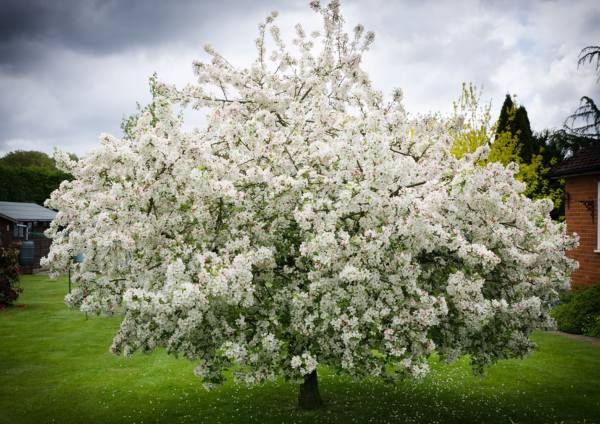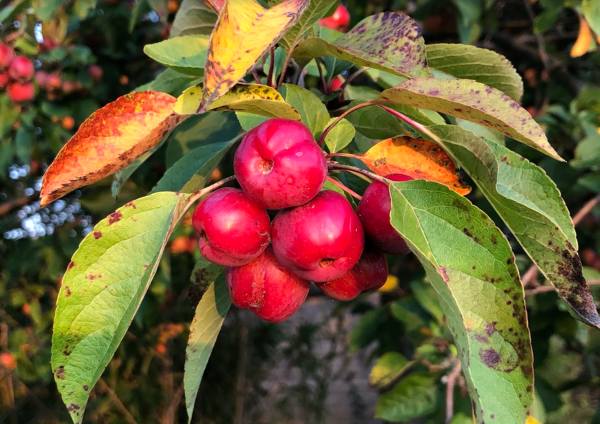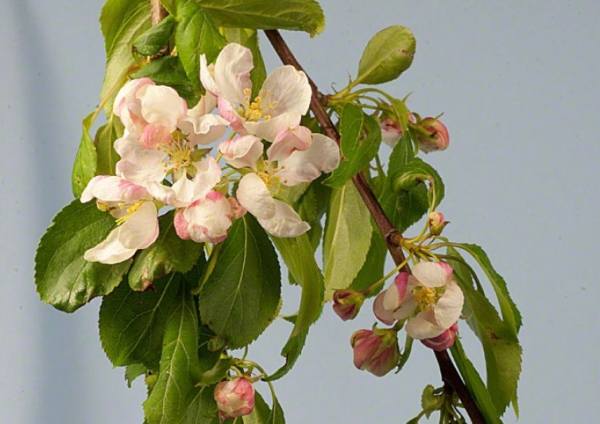Crab apples are beautiful, compact trees with vibrant autumn foliage followed by clusters of buttery yellow, bright ruby red or mellow orange fruits that adorn the branches for many months.
Spring brings prolific flowering with pure white, pink and red blossom, and attractive foliage, often with deep purple tones. Thriving in almost any soil and aspect, the versatile crabapple tree is perfect for injecting colour and interest into the garden all year round.
Autumn Bounty
Originating from Japan, Malus tschonoskii (also called the pillar crab due to its upright habit) has particularly fine autumn colour. From October its rich green leaves take on intense scarlet, yellow and orange hues, making it easy to see why this crab apple received the prestigious RHS Award of Garden Merit for its splendid autumn foliage.
Ever-popular Malus ‘Evereste’ is a disease-resistant, upright variety with fresh white spring flowers opening from scarlet buds and deep green foliage that develops soft yellow, gold and bronze shades in autumn. As well as large fruits that are ideal for jellies, Evereste is an excellent pollinator and another recipient of the RHS Award of Garden Merit.
Winter Interest
Malus ‘Royalty’ also has superb autumn colour with deep purple summer foliage that turns a fiery red later in the year. After the leaves have fallen, striking red-black fruits hang like sultry jewels on the bare branches. Many crab apples retain their attractive fruits in this way through the coldest months, adding an extra dimension to the winter garden. One of my favourites, Malus ‘Red Sentinel’ is a wonderful all-rounder with small, glossy red crabs that look stunning in Christmas decorations. With scented white flowers in spring, soft bronze autumn foliage and good tolerance to pollution, this variety really does have it all.
King of the culinary crabs, Malus ‘John Downie’ has orange-red fruits that make a fabulous jelly and striking reddish gold autumn foliage. Malus ‘Butterball’ produces enormous amounts of pollen in spring, followed by a prodigious crop of rich yellow fruits that ripen in October, providing food for the birds and a vivid yellow jelly. Malus ‘Gorgeous’ and Malus ‘Red Glow’ are also heavy-croppers with fruit that persists on the tree for many months if it is not harvested for use in the kitchen. Both varieties produce high quality crab apples that make delicious preserves.
Spring Blossom
For a profusion of spring blossom, try disease-resistant Malus moerlandsii with its fragrant dark wine-red flowers. As the foliage emerges in spring, its purple-red leaves add to the colourful blossom creating a fantastic ornamental display. Later in the season, the foliage turns deep green, scored with red veins.
Malus ‘Charlotte’ is a North American variety with large, pink scented blooms and spectacular autumn colour. The fragrance resembles that of violets, giving the tree its common name of Sweet Crabapple. The weeping crab apple, Malus ‘Red Jade’ is another beauty with glorious pinky-white flowers hanging from its pendant boughs. In autumn, the weeping canopy turns a buttery yellow and tiny, cherry-like fruit complete the pretty picture.
Perfect for Pollinators
Nectar-rich crab apple blossom provides a valuable source of food for pollinators and varieties like Malus ‘Golden Hornet’, ‘Evereste’ and ‘John Downie’ are excellent orchard pollinators due to their long flowering period. The wild crab apple, Malus sylvestris is another good pollinator for nearby apple crops. A tough and reliable hedging plant, the native crab also provides fruit for the birds during the autumn and winter months. Wild crabapples can be used in a mixed wildlife hedge or grown as a small ornamental tree with a spreading canopy.
How to Plant Bare Root Trees
Bare root crab apples can be planted any time between November and March during their dormant period, provided the ground is not frozen. Dig a square hole one third larger than the root area, enrich the soil with compost and plant the tree to the depth of the soil mark on the trunk, adding mycorrhizal fungi to help the tree become established. Support with a tree stake and protect with a tree guard. Top dress with bonemeal and water well.
For more detailed planting instructions, watch our tree planting video.





Miss Eve Reste was the lady who first propagated and applied for RHS registration of the Eve Reste crab apple tree & holds the RHS Certificated of merit.
Thanks for your answer. We will be in touch in December if you have been selected as the winner.
What Crab apple do you recommend to grow in a large pot, I’m after visual effect rather than making jelly, but like the wildlife to visit my small garden for the fruit.
Thanks Lynda
Hi Lynda
Thanks very much for your email. We would recommend any of our 1/2 Standard crab apple trees (Butterball, Evereste, Gorgeous are good for wildlife), however pots aren’t the best planting recommendation when it comes to crab apple trees as they will become distressed and will want to grow bigger. You would have to re-pot every year to replenish the soil. I hope this helps.
Eve Reste was a famous skier.
Hi Betty
Thanks for your answer. We will be in touch in December if you have been selected as the winner.
What is the best crab apple tree for all year round colour (spring blossom and autumn leaves) and edible crab apples (chalky soil seaside garden)?
Hi Geta,
Crab apples pretty much all score highly in the blossom and autumn colour department, and will be fine on chalk near the sea, although if they have no cover from salt winds that won’t be ideal for their productivity. If you intend to eat the fruit then it doesn’t matter if they are especially ornamental & stay on the branches after autumn.
I have a liking for the really red & purple ones like Royalty and Red Sentinel.
If I had to pick one that is best for fruit, it would be Butterball – high yield and disease free, much more reliable than the popular John Downie in areas where scab is a problem.
Which crab apples hold onto their fruit for the longest during winter please? I’m looking for something help screen off some flats next to me all year round. Thanks.
Hello Suzy, of the ornamental Malus varieties we grow, Red Jade (which is weeping and not as tall as the others, about 4.5metres tops), Profusion and M. sargentii have the most persistent fruit, although M. sargentii tends to be quite a biennial flowerer & therefore cropper. Donald Wyman is also an excellent match for your requirements, but we don’t grow him (yet…)
Hello,
I am thinking of growing a crab apple in our cottage front garden, The soil is quite wet in the winter months and it is south facing so quite dry in the summer months. Also on the acid side. I would like something with a good disease resistance. Nearby eating apple trees seem to suffer from canker. Please could you suggest some suitable varieties.
Thank you
It is difficult to recommend a tree when apple trees in the area suffer from canker however please follow the link below to our list of available crabapple trees.
https://www.ashridgetrees.co.uk/trees/crabapple-trees
I hope this is of help
Kind regards